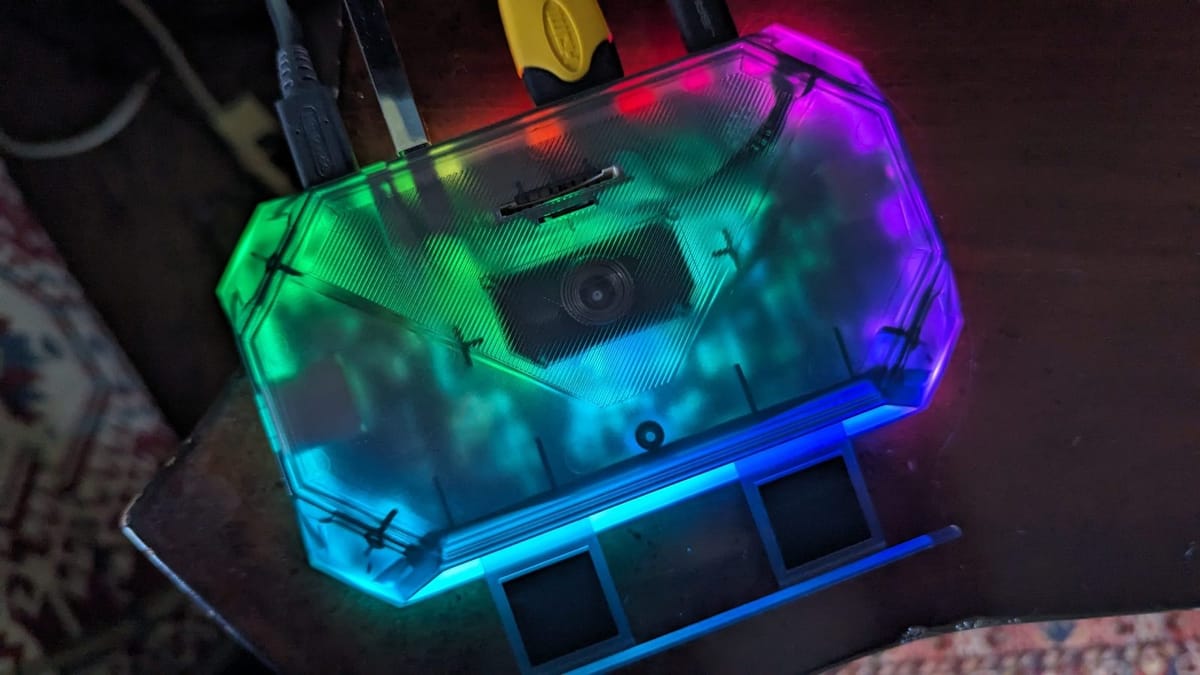
I’ve been searching for a dock to make it seamless to connect my Steam Deck to the TV. I’ve got a great dock already that will do the job, but it’s not something I want to leave hooked up all the time like I do with the Nintendo Switch dock. Sure the official dock would be great for that, but what if I pick up another device like the Lenovo Legion Go and want to use it with that? I need something more universal, but just as compact and easy to use. Here’s where the JSAUX RGB Docking Station comes in: it’s got a ton of ports for everything and even a stand where the device can sit while in use. Over the past week, I’ve put it through its paces, and while it can take some time to learn all the ins and outs it’s a great addition to my gaming room.
Opening up the box, you’ve got all the usual stuff: the device itself, a short USB-C cable to connect the device and the Deck, and a bunch of warranty and legal jargon. The one thing missing is a manual! Yes, you’re going to have to figure out how everything works here on your own. Most of the ports are labeled with a sticker when you first take the dock out, but there are other features here that could have really used at least a quick start guide. For example, I had to look at the product page’s images to figure out that the button on the front actually slides out, revealing a shelf for your handheld to sit on. It’s also not entirely obvious how to turn off the RGB, as you press in on the top of the device in a very specific spot rather than a traditional button.

Once you get past the learning curve though, using the dock is absolutely seamless. Just sit it down and plug your device in and it’ll automatically start charging and outputting through HDMI or DisplayPort provided those are connected. It’s low profile enough to be barely noticeable when not in use, though you can turn the RGB on if you want something flashier.
I tested a bunch of games on here using my Steam Deck including Resident Evil 4 Remake, Cyberpunk 2077, the upcoming Penny’s Big Breakaway, Persona 3 Reload, Hi-Fi Rush, and The Legend of Heroes: Trails Through Daybreak using the fan translation. The only game I tested that refused to work was Final Fantasy XI, as Play Online would start but present a blank screen. Aside from that, I did have a few issues with some of these games, though I’m not sure that’s the fault of the dock. Daybreak’s text was incredibly low resolution and difficult to read even after going above 720p, though that problem is also present when playing on the Deck’s screen. I also noticed a small amount of input lag in Hi-Fi Rush, which wasn’t game breaking but definitely noticeable having played through the game several times.

While the JSAUX does support HDR and VRR, I couldn’t test the latter and the former never looked quite right to me. With HDR on, games would look very desaturated even after adjusting settings extensively. Given that I don’t have a fancy OLED Deck that supports HDR on the built-in screen it’s difficult to test if this is the fault of the dock or the Deck, but games look fine enough with it off.
When first plugging in my Deck, I did have to mess around with the settings a bit to calibrate the display area. By default, the Steam Deck interface would be slightly bigger than my TV, with the profile picture and online status in the top right corner being cut off, for example. It’s not a difficult fix as you just pop into settings and move some sliders around, but it’s worth noting as I haven’t had this issue with any other dock.

After making backups of my physical games like Rogue Galaxy (PS2), Kirby’s Air Ride (GameCube), and The Legend of Zelda: The Wind Waker HD (Wii U), I tested out the USB ports on the back to transfer the games for emulation. Usually a transfer like this will (along with the Linkle mod for Wind Waker) take quite a while, but it was much faster with the dock. The website lists the USB 2.0 port transferring 480 Mbps, while the 3.2 port can go up to 10 Gbps. My experience lied somewhere in the middle, but was still pretty dang fast.
After copying it over from my PC, I also played through the entirety of Silent Hill 2’s fan made Enhanced Edition patch. It performed flawlessly at 60fps, and easily swapped between 16:10 and 16:9 when starting the game out of and in the dock respectively. I think that’s a good indicator of the kind of experience the JSAUX RGB Docking Station provides. It’s simply easy to use, and provides a quality experience.
JSAUX RGB Docking Station
Excellent
Despite a learning curve thanks to having no manual, the JSAUX RGB Docking Station is one of the most convenient docks out there. It’s easy to set up and use at a moment’s notice, and anything you output through it will look great. The HDR does leave much to be desired, but the incredibly fast data transfer speeds make this dock a great choice for anyone who likes to tinker with their device, but also have the ease of use similar to the Switch.
Pros
- Games look great through it
- Incredibly fast transfer speeds
- Has a stand for your handheld PC
Cons
- HDR looks bad
- No manual
- Not quite perfect out of the box
